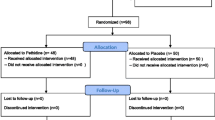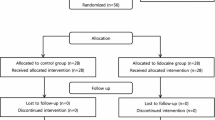Abstract
Purpose: To determine if intraarterial lidocaine reduces pain during and after chemoembolization, and whether it influences postprocedure recovery.
Methods: Two patient cohorts undergoing selective hepatic chemoembolization were compared. Chemoembolization was performed without lidocaine (control group) in 27 patients and intraarterial lidocaine was used (lidocaine group) in 29 similar patients. Objective changes in patient management were assessed. Pain reduction in 31 more procedures with lidocaine (total 60) was assessed and related to tumor type.
Results: During chemoembolization, intraarterial lidocaine reduced the need for additional intravenous analgesics from 69% to 19%. After chemoembolization the mean Dilaudid dose in the first 24 hr was reduced from 9.5 mg to 4.15 mg; accordingly, the mean length of hospital stay was reduced from 67.5 to 53.5 hr. During the day of chemoembolization, the mean oral fluid intake increased from 420 ml (control group) to 487 ml (lidocaine group); the percentage of patients taking solid food on the day of chemoembolization increased from 3% to 43%.
Conclusion: Intraarterial lidocaine during chemoembolization reduces the severity and duration of pain after chemoembolization resulting in faster recovery thus reducing the length of hospitalization.
Similar content being viewed by others
References
Pentecost MJ (1993) Transcatheter treatment of hepatic metastases. AJR 160:1171–1175
Miller DL (1996) First, do no harm. Radiology 198:10–12
Groupe d’Etude et de Traitement du Carcinome Hepatocellulaire (1995) A comparison of lipiodol chemoembolization and conservative treatment for unresectable hepatocellular carcinoma. N Engl J Med 332:1256–1261
Bismuth H, Morino M, Sherlock D, Castaing D, Miglietta C, Cauquil P, Roche A (1992) Primary treatment of hepatocellular carcinoma by arterial chemoembolization. Am J Surg 163:387–394
Hajarizadeh H, Ivancev K, Mueller CR, Fletcher WS, Woltering E (1992) Effective palliative treatment of metastatic carcinoid tumors with intra-arterial chemotherapy/chemoembolization combined with octreotide acetate. Am J Surg 163:479–483
Nakamura H, Mitani T, Murakami T, Hashimoto T, Tsuda K, Nakanishi K, Ishida T, Tomoda K, Hori S, Kozuka T (1994) Five-year survival after transcatheter chemoembolization for hepatocellular carcinoma. Cancer Chemother Pharmacol 33:S89-S92
Clouse ME, Stokes KR, Kruskal JB, Perry LJ, Stuart KE, Nasser IA (1993) Chemoembolization for hepatocellular carcinoma: Epinephrine followed by a doxorubicin-ethiodized oil emulsion and gelatin sponge powder. J Vase Interv Radiol 4:717–725
Daniels J, Pentecost M, Teitelbaum G, Stanley P (1992) Hepatic artery chemoembolization for carcinoma of colon using angiostat collagen and cisplatin, mitomycin and doxorubicin: Response, survival and serum drug levels. Proc Ann Meet Am Soc Clin Oncol 11:A497
Perry LJ, Stuart K, Stokes KR, Clouse ME (1994) Hepatic arterial chemoembolization for metastatic neuroendocrine tumors. Surgery 116:1111–1117
Gates J, Hartneil GG, Stuart K, Clouse ME (1999) Chemoembolization of hepatic neoplasms: Safety, complications and when to worry. Radiographics 19:399–414
Farinati F, De Maria N, Marafin C, Herszenyi L, Del Prato S, Rinaldi M, Perini L, Cardin R, Naccarato R (1996) Unresectable hepatocellular carcinoma in cirrhosis: Survival, prognostic factors, and unexpected side effects after transcatheter arterial chemoembolization. Dig Dis Sei 41:2332–2339
Berger DH, Carrasco CH, Hohn DC, Curley SA (1995) Hepatic artery chemoembolization or embolization for primary and metastatic liver tumors: Post-treatment management and complications. J Surg Oncol 60:116–121
Kolmannskog F, Kolbenstvedt AN, Schrumpf E, Hanssen LE (1991) Side effects and complications after hepatic artery embolization in the carcinoid syndrome. Scand J Gastroenterol 26:557–562
Molgaard CP, Teitelbaum GP, Pentecost M, Finck EJ, Davis SH, Dziubinski JE, Daniels JR (1990) Intraarterial administration of lido-caine for analgesia in hepatic chemoembolization. J Vase Interv Radiol 1:81–85
Essentials of ACLS (1994) In: Cummins RO (ed) Advanced Cardiac Life Support. American Heart Association, pp 1–18
Novak D (1990) Complications of arterial embolization. In: Dondelinger RF (ed) Interventional Radiology, Thieme, Stuttgart, pp 314–324
Author information
Authors and Affiliations
Rights and permissions
About this article
Cite this article
Hartnell, G.G., Gates, J., Stuart, K. et al. Hepatic chemoembolization: Effect of intraarterial lidocaine on pain and postprocedure recovery. Cardiovasc Intervent Radiol 22, 293–297 (1999). https://doi.org/10.1007/s002709900391
Issue Date:
DOI: https://doi.org/10.1007/s002709900391




